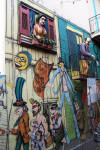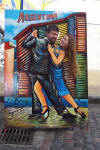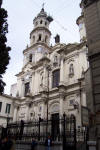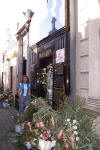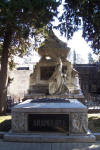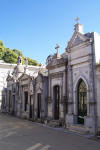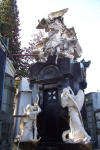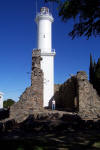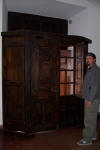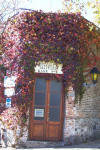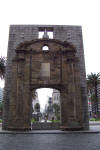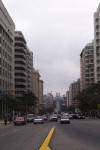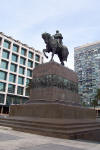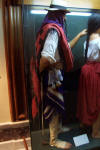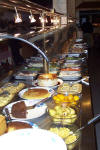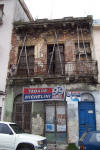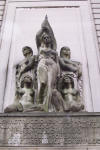Diary/Photo Journal
Week of May 08, 2005
This week still had us in Buenos Aires and we just went through our long list of all the places we wanted to visit and all the events we wanted to experience. We definitely made good use of our time.
On Sundays, fairs abound in many of the "barrios" and several are quite well-known for their "artesenians" and food. We made for La Boca, a rather quirky port barrio that has livened up their drab existence by painting the exteriors of the buildings in charmingly garish colors. Accompany this with numerous "artists" and crafters selling their wares, and you have a great little node within the barrio with an enthusiastic vibe.
  |
The famous "Caminita" of La Boca Love the colors |
  |
Examples of the quirky artists humor are everywhere |
We wandered around aimlessly, taking time to inspect the wonderful hand crafts and colorful artwork that lined the streets. As with many tourist nooks, the restaurants call attention to themselves by soliciting you as you walk nearby. I am usually very put off by these restaurant "barkers" and we generally find the more out-of-the-way place to enjoy our mid-day meal. However, a very polite, respectful young man carefully handed me a small menu sheet and because of his kind demeanor, we returned to the establishment.
The restaurant was a typical "parillada" that serves a multitude of meats on a small grill to your table. The food was terrific and with the assistance of a "tango" singer, the ambiance was fitting. However, as with all tourist places, one must be ever-persistent and extremely aware of your belongings at all times. While we were enjoying our lunch, an unfortunate couple just behind us experienced the theft of the woman's purse. She had carelessly hung it over the back of her chair and even though she never left her seat, she forgot about its existence just long enough for someone to walk by and lift the purse from its perch.
As is our habit, we get a table for four and use the additional two chairs as either a buffer to the space between tables or if against a wall, the place to stash our goods. If one of us has to go to the bathroom or to the buffet, the other remains and watches the table. If we both get up, we carry everything with us. You just cannot be too careful no matter how nice the establishment, the street or the city.
After lunch, we taxied our way over to yet another popular fair in the barrio of San Telmo. San Telmo is known for its artists and large antiques market and it did not disappoint. Again, we walked the labyrinth of kiosks and watched the various performers entertaining the crowds. One particular singer/guitarist caught our ears and we gladly bought his CD.
My favorite was a lone puppeteer that had the people laughing out loud with his presentation. The puppet held a bottle of booze and wobbled about to a dark and oh-so-sad tango song about the woes of alcohol and the loss of his woman. The puppet would hang onto the light pole, fall off his stage, crawl on his hands and knees, take a swig from his bottle, all the time lamenting his pitiful condition. The puppeteer's timing was impeccable and you forgot that the focus of your attention was a mere puppet.
We also had the great fortune of watching a futbol game between Boca Juniors and Argentino Juniors ("Junior" being a nickname of sorts and has nothing to do with their ages). These two teams are rather famous in Argentina and well-known throughout South America and the game was important for the team's placement going into playoffs. Boca Juniors lost 2-1 and our great seats allowed us to witness some great plays up close and personal.
To give you an idea how passionate Argentines (and a certain Brazilian that will go unnamed) are about their futbol, here is a quote from a devoted fan: "You can change your job, your house, your wife, even your sexual orientation...but you can never change your futbol team!"
We had a nice surprise when we returned to our hotel after the futbol game for Larry and Marylyn (and of course, Poppet), had found their way to Buenos Aires after their sojourn to western Argentina. We had a long catch-up talk and were happy to find out that other than a day of not feeling well, they had a terrific experience around areas referred to as the Lake District and through the province of Neuquen. If you would like to keep up with what Larry and Marylyn are doing, you can catch them online at: www.ocregister.com/irvine and click on the "Diary from South America" heading on the right side of the main page. The Orange County Register is featuring them in an ongoing account of their year-long odyssey in South America.
|
|
Catching up with Larry and Marylyn with our most favorite website |
 |
We had a nice dinner with Larry and
Marylyn and even Poppet (she was cleverly hidden on Marylyn's lap and under her jacket |
One thing that is great about Buenos Aires is that it has quite efficient subway system called the "subte" and it gives Buenos Aires bragging rights for possessing South America's oldest subway. Built in 1913, the subte still runs with many of its ancient cars and are easily distinguished from modern trams by their rich wood interiors and large metal emergency brakes. Riding in these cars feels like an old wooden roller coaster ride where you jostle back and forth as you trundle down the track.
Zipping around the city either by subte or by taxi was relatively easy and economical. There is something to be said about not having to drive and hassle with the traffic. Taking advantage of the public transportation, we visited yet another neighborhood near Palermo called Recoleta. As mentioned on the previous page, Eva "Evita" Peron was entombed in the Cemeterio de la Recoleta to the horror of much of the elite society in Buenos Aires. How she got to Recoleta is truly an intriguing story.
Evita's body was "kidnapped" by a rival of Juan Peron (General Pedro Aramburu) and taken to a little-known cemetery in Milan and then to Madrid. After trying to get the Vatican to sequester her cadaver and failing, Evita was returned to Buenos Aires in 1974 to rest in a subterranean vault (remember, she died in 1952).
And, if this cadaver-napping was not enough, Aramburu, the bitter rival that stole Evita's body, also had his remains held for "ransom" by supporters of the Perons (after his assassination in 1970). Only when the government in place in 1974 ensured Evita's return did Aramburu's body reappear for entombment in Recoleta, coincidentally enough, only a short distance away from Evita. Argentines take their politics, alive or dead, very seriously.
Again, walking through the cemeterios may seem a little creepy, alright, a lot creepy; however, they are so amazing and interesting. Many of the interiors are visible through the glass doors and several coffins and ornate cremation containers are peacefully displayed. Some of the elaborate coffins are very small and viewing these throws a blanket of sadness over an already solemn mood.
Our last day in Buenos Aires saw us getting Cindy prepared for her next push and joining Larry and Marylyn for dinner. We said our good-byes and are already looking forward to seeing them in Brasil. We actually had to set our alarm clock to awaken early the next morning so we could make the ferry from Buenos Aires to Colonia, Uruguay. I forgot how much I loathe those contraptions.
We proceeded through customs with the usual bureaucratic paperwork and made it onto the ferry for the three-hour tour across the Parana River. This river may be familiar to those of you that actually read this webpage and not pull the X-rated magazine stunt of just looking at the pictures (yeah right, you read the articles). The Parana River courses through Brasil and combines with the Iguassu River after the Iguassu's waters are thrown over the Iguassu falls. If you need a reminder of that magnificent and magical place, a quick click here will get you there.
We quickly disembarked and found Cindy a nice, shady tree-lined street to rest while we enjoyed a terrific lunch and a lengthy walkabout Colonia, Uruguay. Appropriately named, Colonia is a step back into a Colonial time seemingly forgotten. Built in 1680, it still retains its charmingly attractive "village" feel and because of this, UNESCO has proclaimed the Barrio Historico a World Cultural Heritage site. And Uruguay itself, being wedged in between Brasil and Argentina, is somewhat a buffer between the super-countries and as a result, has become known as the "Switzerland" of South America. For a small country, Uruguay has quite a specialness about it. Not to mention that it sits in a similar latitude (southern hemisphere) to that of Los Angeles and the weather is quite temperate.
For the price of $1 for both of us, we were given access to not one, but six museums throughout Colonia. Each museum was a collection or a restored home owned by a private person or small group that maintains the antiquities for the enjoyment of the public. From the Casa Rosada, the first Portuguese home in Colonia, to the various artifacts of china, pottery, tiles, clothing, etc. retained from the original settlement. Again, it was a walk back in time (and a lot of ducking through the low doorways).
We found a great campsite on the Parana River and we did not waste any time to catch what promised to be a spectacular sunset. You be the judge on where this sunset would rate on your scale of greatest sunsets.
  |
How's that for our first night in
Uruguay. Glorious! |
As the weather was hinting at becoming inclement, we decided to forgo time at the shore and we made our way to Montevideo a day earlier than planned. Fortunately for us, we read the weather signs correctly as we endured wind and rain in Uruguay's capital city. Home to 1.5 million of the 3.3 million citizens of Uruguay, Montevideo is the only city that can truly be called a "city" in South America's second smallest country.
On our way to Montevideo, we, or shall I say Cindy, hit a milestone. She is officially a "centenarian" as she turned over to 100,000 miles.
|
|
The moment of truth Cindy has been born again according to her odometer |
  |
Typical Uruguayan countryside |
We just beat the rains into Montevideo and easily found a place for Cindy and a nearby hotel for us. As you can imagine, camping in or very near a major city is almost impossible so we alter our traveling to the "hotel and estacionamento" mode.
Montevideo is a wonderful city as much of the architecture has been preserved since the 1700's and retains its colonial charm. Because Uruguay is not a "rich" country, the populace maintains, restores and respects some of its old buildings (and that goes for cars as many 1940's and 1950's cars are seen) instead of demolishing and rebuilding with boring monoliths. However, that is also the sad part because many buildings are in desperate need of restoration and are on the verge of total collapse. We did enjoy our usual city walk even though we dodged the sporadic rain showers..
We always enjoy strolling among the city's and the country's treasured monuments as these special places always gift you with an understanding of their culture and especially, their history. One such intriguing place was the Palacio de Heber which houses the "gaucho museum". The South American "Gaucho" can be compared to the North American cowboy only in their romantic glorification and their historical importance to the development of both areas. The gaucho, idealized as being courteous, independent and generous as well as ferocious fighters, found their way into history that many Argentines and Uruguayans hold close to their cultural hearts.
The Palacio de Heber, once a home for a wealthy Uruguayan, is a museum in itself with its intricate wood detailing and its ornate plaster reliefs.
 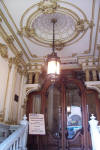 |
Palacio de Heber, built in 1896 The original entry parlor |
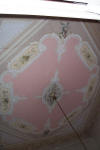 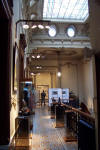 |
The ceilings had as much to look at as the walls, the floors and all of the exhibits throughout the Palacio de Heber |
The gaucho has very distinct traits and "costume" that are unique to this "vagrant". From his animal-skin wrapped feet (not including the toes), to his loose fitting "bambacha" (pants), to his boleaderas and chicotes (triple roped "weapon" and whip), to his sharp "falcon" at his hip, to his elaborate silver stirrups and spurs, he presented quite the striking quixotic figure.
Another significant cultural practice in this part of South America is the drinking of "mate" (mah-tay). Mate is a powdered leaf, much like tea. You fill your special mate cup (as you can see in the photo above, these cups are rather elaborate) and you pour hot water into the cup. By using a small, spoon-like straw (bomba) that contains minute holes at its base, you suck the hot liquid out from the leaves. As you drink the mate, you pour in more hot water and continue to extract the juice.
Personally, I found mate to taste something akin to drinking dirt. I am convinced that when I hear "it's an acquired taste" that that is a euphemism for "it was forced on us as kids and we drink/eat it because we have to". I rate mate with other so-called "acquired" tastes such as: vegemite, haggis (sic), intestines, mountain oysters, cod liver oil, etc. The stuff is absolutely horrid. I would rather suck on a rock...blech...
After our historic self-tour, we found a typical "tenedor libre" or parilla buffet. These type of restaurants are fast becoming a favorite with us as they always have a terrific variety of food and the all-important "parilla" or bar-b-que of many different meats.
Another stormy day greeted us so we just leaned into the wind and had lunch at Montevideo's famous Mercado del Puerto where many "parillas" compete for the customers inside an old, huge port warehouse. We took a long walk along the shore; however, the blasting rain drove us into our snug hotel for the rest of the day. Thus far, we really have been fortunate because but for this day, we have not really been hampered by the weather. And, because we had cable TV with lots of futbol, we managed to endure several hours indoors.
Home Page South America Diary Index Previous Diary page SA Diary page 38
